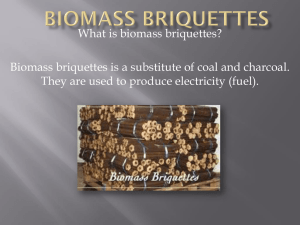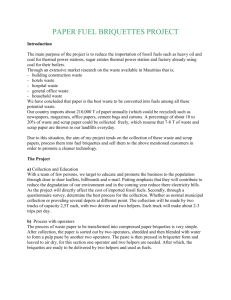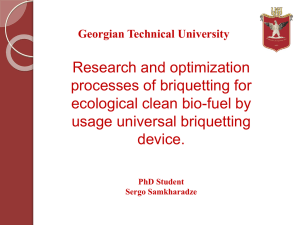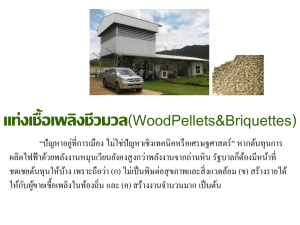Recycling Waste into Fuel Briquettes Kenya
advertisement
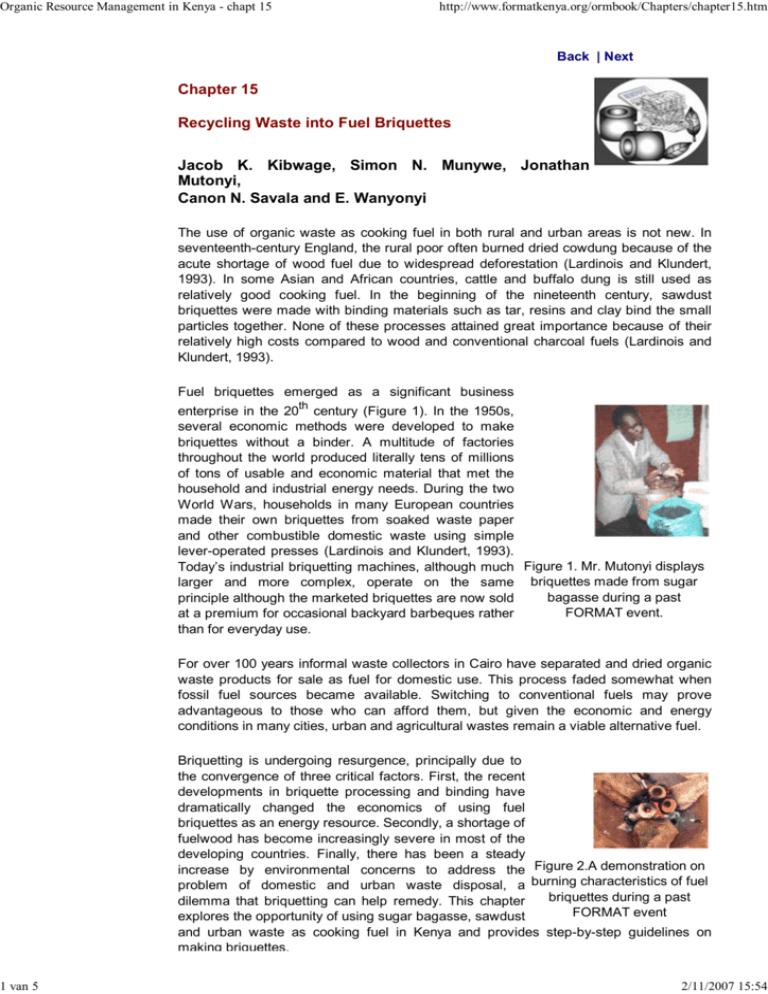
Organic Resource Management in Kenya - chapt 15 1 van 5 http://www.formatkenya.org/ormbook/Chapters/chapter15.htm Back | Next Chapter 15 Recycling Waste into Fuel Briquettes Jacob K. Kibwage, Simon N. Munywe, Jonathan Mutonyi, Canon N. Savala and E. Wanyonyi The use of organic waste as cooking fuel in both rural and urban areas is not new. In seventeenth-century England, the rural poor often burned dried cowdung because of the acute shortage of wood fuel due to widespread deforestation (Lardinois and Klundert, 1993). In some Asian and African countries, cattle and buffalo dung is still used as relatively good cooking fuel. In the beginning of the nineteenth century, sawdust briquettes were made with binding materials such as tar, resins and clay bind the small particles together. None of these processes attained great importance because of their relatively high costs compared to wood and conventional charcoal fuels (Lardinois and Klundert, 1993). Fuel briquettes emerged as a significant business enterprise in the 20th century (Figure 1). In the 1950s, several economic methods were developed to make briquettes without a binder. A multitude of factories throughout the world produced literally tens of millions of tons of usable and economic material that met the household and industrial energy needs. During the two World Wars, households in many European countries made their own briquettes from soaked waste paper and other combustible domestic waste using simple lever-operated presses (Lardinois and Klundert, 1993). Today’s industrial briquetting machines, although much Figure 1. Mr. Mutonyi displays larger and more complex, operate on the same briquettes made from sugar bagasse during a past principle although the marketed briquettes are now sold FORMAT event. at a premium for occasional backyard barbeques rather than for everyday use. For over 100 years informal waste collectors in Cairo have separated and dried organic waste products for sale as fuel for domestic use. This process faded somewhat when fossil fuel sources became available. Switching to conventional fuels may prove advantageous to those who can afford them, but given the economic and energy conditions in many cities, urban and agricultural wastes remain a viable alternative fuel. Briquetting is undergoing resurgence, principally due to the convergence of three critical factors. First, the recent developments in briquette processing and binding have dramatically changed the economics of using fuel briquettes as an energy resource. Secondly, a shortage of fuelwood has become increasingly severe in most of the developing countries. Finally, there has been a steady increase by environmental concerns to address the Figure 2.A demonstration on problem of domestic and urban waste disposal, a burning characteristics of fuel briquettes during a past dilemma that briquetting can help remedy. This chapter FORMAT event explores the opportunity of using sugar bagasse, sawdust and urban waste as cooking fuel in Kenya and provides step-by-step guidelines on making briquettes. 2/11/2007 15:54 Organic Resource Management in Kenya - chapt 15 2 van 5 http://www.formatkenya.org/ormbook/Chapters/chapter15.htm making briquettes. Making Fuel Briquettes Briquetting involves the collection of combustible materials that are not usable as such because of their low density, and compressing them into a solid fuel product of any convenient shape that can be burned like wood or charcoal (Figure 2). Thus, the material is compressed to form a product of higher bulk density, lower moisture content, and uniform size, shape and material properties. Briquettes are easier to package and store, cheaper to transport, more convenient to use, and their burning characteristics are better than those of the original organic waste material. The raw material of a briquette must bind during compression; otherwise, when the briquette is removed from the mould, it will crumble. Improved cohesion can be obtained with a binder but also without, since under high temperature and pressure, some materials such as wood bind naturally. A binder must not cause smoke or gummy deposits, while the creation of excess dust must also be avoided. Two different sorts of binders may be employed. Combustible binders are prepared from natural or synthetic resins, animal manure or treated, dewatered sewage sludge. Non-combustible binders include clay, cement and other adhesive minerals. Although combustible binders are preferable, non-combustible binders may be suitable if used in sufficiently low concentrations. For example, if organic waste is mixed with too much clay, the briquettes will not easily ignite or burn uniformly. Suitable binders include starch (5 to 10%) or molasses (15 to 25%) although their use can prove expensive (Lardinois and Klundert, 1993). It is important to identify additional, inexpensive materials to serve as briquette binders in Kenya and their optimum concentrations. The exact method of preparation depends upon the material being briquetted as illustrated in the following three cases of compressing sugar bagasse, sawdust and urban waste into cooking briquettes. Year Harvested Fibre Cane Milled Estimated Est. Used Excess Area (ha) % Bagasse Bagasse Bagasse Cane ----------------------------ton---------------------------------------------1995 6134.7 17.6 424427.3 74571.9 51805.6 22766.3 1996 3747.2 18.3 306438.7 56078.3 39640.9 16437.4 1997 5579.6 18.3 453618.5 82966.8 58634.7 24332.1 1998 5697.7 17.7 471135.4 83249.6 57977.9 25271.7 1999 9192.4 17.2 602528.3 103755.4 71435.8 32319.6 2000 6919.1 16.6 320421.4 53157.9 35970.5 17187.4 Fuel briquettes from sugarcane bagasse Surplus bagasse presents a disposal problem for many sugar factories. For example, at Nzoia Sugar Factory in Western Kenya, the average tonnage of excess bagasse produced per year is over 24000 tons (Table 1). Using a bagasse-to-briquette conversion ratio of 5:1, Nzoia could produce 4845 tons of bagasse charcoal briquettes (Keya et al., 2000). The pilot briquetting technology remains simple, applicable and of benefit to surrounding communities, and a low cost product that competes with wood charcoal is now being test marketed. The production of carbonized bagasse briquettes by Chardust Ltd. based at Chemelil Sugar factory involves the following stages: 1. Size reduction. Chop, rolling or hammer fresh sugarcane bagasse 2. Drying. Remove moisture in the bagasse by open air drying or by using forced, heated air in a large rotating drum 3. Carbonization. Combust the dried bagasse under limited oxygen conditions in a 2/11/2007 15:54 Organic Resource Management in Kenya - chapt 15 3 van 5 4. 5. 6. 7. http://www.formatkenya.org/ormbook/Chapters/chapter15.htm buried pit or trench until it carbonizes into charcoal Preparation of feedstock. Mix carbonized bagasse with binder (e.g. clay or molasses) to form the briquette feedstock Compaction and extrusion. Pass the material through a machine- or manually-operated extruder to form “rolls” of charcoal. Dry the rolls. Air dry the rolls for 1 to 3 days, causing them to break into chunks Package and market. Package the briquettes in 2 kg labeled bags and sell for a market price of KSh 30 (US $0.40) The product is sold under the trade name CaneCoal. It is less expensive than regular charcoal and its use conserves diminishing forest resources in Western Kenya. Its marketing strategy is to produce lower-cost briquettes that light quickly and burn longer without producing sparks, smoke or unpleasant odors. Fuel briquettes from sawdust Sawdust is waste material from all types of primary and secondary wood processing. Between 10 and 13% of a log is reduced to sawdust in milling operations. Sawdust is bulky, and is therefore expensive to store and transport. Also, the calorific value of sawdust is quite low, so that briquetting is an ideal way to reduce the bulk, to increase the density, and thus to increase the calorific value. The equipment required for producing sawdust briquettes consist of a drier, a press and an extruder with a tapered screw and a large revolving disk. The sawdust briquettes are formed under sufficiently high pressure to produce cohesion between wood particles. The lignin softens and binds the briquette, so no additional binder is required. The sawdust fuel briquettes are cylindrical, with a diameter of 11.5 cm and length of 30.5 cm. They are packed into 40 kg bags. The advantages of producing sawdust fuel briquettes include: The price of sawdust fuel briquettes is about the same as fuel wood but is much more convenient to use as they do not require further cutting and chopping They burn very well in any kind of solid fuel stove and boiler The ignite quickly and burn cleanly, producing only 1% to 6 % ash The briquettes don't contain sulphur and burn without producing odor The burning of 1 kg of sawdust fuel briquettes produces 18000 KJ caloric power, roughly equivalent that of medium quality coal A briquette plant may be profitably integrated into larger sawmilling operations Due to present limitations of equipment currently available in Kenya, locally-produced sawdust briquettes have suboptimal densities, causing incomplete burn and excess smoke. Attempts are underway to improve this technology, particularly by adjusting the screw length to diameter ratio, the screw rotation speed, feed pressure, and residence time in the extension chamber as a means of Figure 3. Two briquetting devices producing a higher-density, better quality briquette. developed in Kenya that were displayed at a FORMAT event by Fuel briquettes from urban waste the Millennium Fuel Project (left) and the Kayole Environmental Solid waste disposal is one of the most serious Management Association (right). urban environmental problems in developing countries. In Kenya, municipal authorities collect and dispose less than 40% of these wastes. This failure is attributed to inadequate resource mobilisation, over-reliance on imported equipment, use of inappropriate technology, lack of public awareness on waste management, absence of sufficient capacity for waste processing and recycling, and non-implementation of environmental laws pertaining to 2/11/2007 15:54 Organic Resource Management in Kenya - chapt 15 4 van 5 http://www.formatkenya.org/ormbook/Chapters/chapter15.htm processing and recycling, and non-implementation of environmental laws pertaining to waste disposal (Kibwage, 2002). Open or crude dumping is the most common method used by municipal authorities. Waste poses a health hazard when it lies scattered in the streets and at the dumping sites. It is now an accepted environmental philosophy that wastes have value and should be utilized based on the four “R”s “Reduce, Reuse, Recover and Recycle”. Through recycling, urban wastes are transformed into useful products. Waste paper and leaves, in particular, provide a potentially important, alternative source of cooking fuel. Waste paper and leaves are molded into cylindrically-shaped products using simple hand operated equipment (Figure 3). Conversion of organic wastes into cylindrical fuel briquettes is being undertaken by several NGOs and CBOs in the country. Both at Nairobi’s Millennium Fuel Project and the Kayole Environmental Management Association (KEMA), briquette making is a priority activity because of the profits involved. The briquettes represent an alternative source of cooking energy and a viable opportunity for income generation, while at the same time contribute to environmental preservation. The Kayole Environmental Management Association has employed street boys to collect garbage from the residents of Kayole Estate within Nairobi City. Garbage is also collected from the streets and dumping grounds. Collected garbage is sorted and non-useful materials are disposed (Figure 4). Selected useful materials are either sold directly to waste recycling industries or used by the association to produce woven handicrafts, compost and fuel briquettes. Figure 4. Activities undertaken by KEMA during its waste management work KEMA has developed an innovative screw-operated device that compacts organic wastes into cooking briquettes (Figure 3). Wastes must be sorted prior to the briquetting process by removing all metals, plastics, and other non-combustible materials, reducing their moisture content to at least 20% and chopping courser feedstock into pieces 1.0 to 2.0 cm or less. To make 100 briquettes, follow these seven steps: 1. Collect waste paper, cartons and dry leaves (about 10 kg when dry) 2. Soak these materials in water for 3 hours 3. Add charcoal powder (about 0.5 kg) to colour the Figure 5. A simple briquettes (optional) electrical powered 4. Pulverize the materials into mash using a large mortar briquetting machine and pestle 2/11/2007 15:54 Organic Resource Management in Kenya - chapt 15 5 van 5 http://www.formatkenya.org/ormbook/Chapters/chapter15.htm and pestle 5. Place mash into the compression cylinder of the briquette maker 6. Compress and drain the mash 7. Remove the briquette and dry for two or three days Three dried briquettes will burn for at least 3 hours and are sufficient to prepare tea and a traditional Kenyan meal such as githeri (a mixture of potatoes, maize and beans). Conclusion Recycling of organic materials into fuel briquettes contributes to solving urban needs such as income-generation, insufficient land for waste disposal and maintaining environmental quality. Since the earth’s resources are finite, greater resource recovery and utilization are essential to achieve an acceptable level of organic waste management. Enhancing the recovery of organic waste can restore various natural cycles, thus preventing the loss of raw materials, energy and nutrients. On the other hand, the demand for energy in Kenya is expected to add to the emission of greenhouse gas through burning of fossil fuels. There is urgent need to promote climate-friendly technologies in Kenya and other developing countries in Africa and fuel briquetting appears to be one such technology that addresses the multiple needs of society and the environment. Current research addresses is focused upon finding better binders for bagasse briquettes, improved calorific values and combustion by producing higher density briquettes, introducing more efficient extrusion methods (Figure 5) and reducing production costs. When the market price of briquettes is less than that of wood charcoal and a regular supply of briquettes is assured, then many new market and environmental opportunities emerge. References Keya, N.C.O. 2000. Nzoia Sugar Company Annual Reports 1980-2000. Nzoia Sugar Company. Bungoma, Kenya. Kibwage, J.K. 2002. Integrating the Informal Recycling Sector into the Solid Waste Management Planning in Nairobi City. Ph.D. Thesis, Maseno University, Kenya. Lardinois, I and Klundert, A. 1993. Organic Waste: Options for Small-Scale Resource Recovery. WASTE Consultants. The Netherlands. 2/11/2007 15:54
